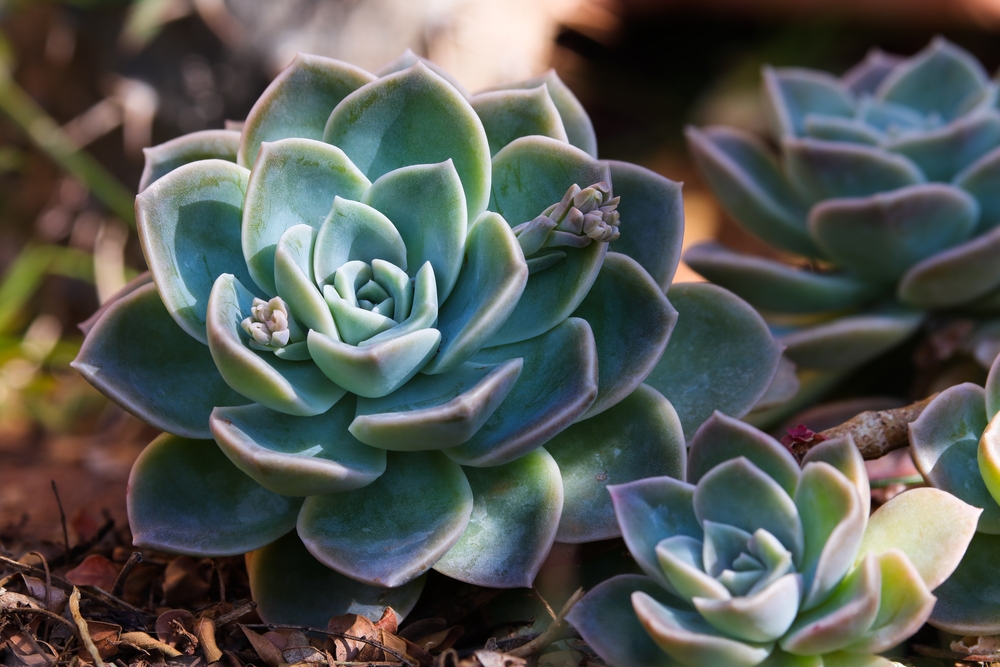
There are many reasons to love blue succulents. They’re gorgeous, unique and add color to any garden. So, what are the best blue succulents to consider for your garden?
8 blue succulents to grow in your garden include the butterfly agave, blue agave, and ice plant. There’s also the blue bird, blue prince, jeweled crown, blue torch cactus, and blue chalkstick.
So if you’re searching for the best blue succulent for your garden, keep reading. This list includes favorites among succulent experts and includes common and rare varieties.
1. Agave potatorum ‘Butterfly Agave’
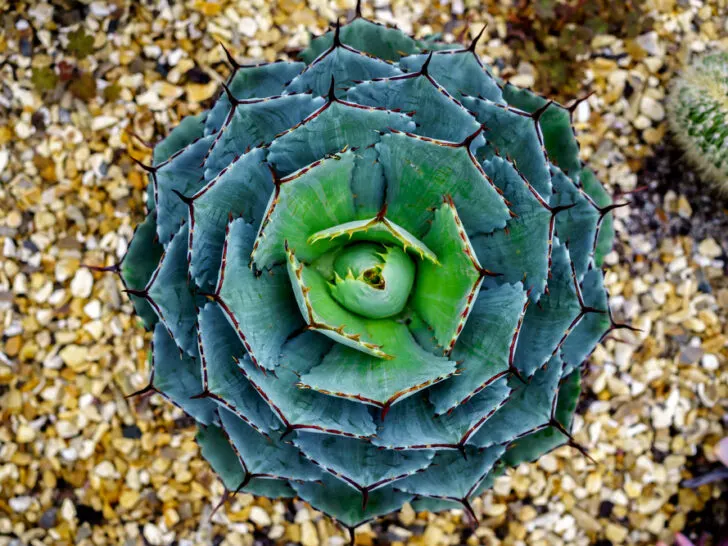
The butterfly agave (or Agave potatorum) is a native Mexican blue succulent. This beautiful plant grows to about 2 feet wide (61 cm) and has fleshy, blue-green leaves edged in white.
When the butterfly agave flowers, its spike can reach a height of 20 feet (7 meters). The flowers feature pale yellow-green leaves with red bracts.
The butterfly agave’s leaves have angular tips and form an attractive rosette pattern, while the flower stalk grows through the middle of the rosette.
The butterfly agave is an easy plant to care for and is drought-tolerant. This means it does best in full sun to partial shade and requires well-draining soil. The butterfly agave reproduces by offsets or seeds.
Blue-green agave flowers add beauty to your garden and can attract butterflies and hummingbirds. They look beautiful when planted with green or lighter-colored succulents or in outdoor plant pots.
2. Agave tequilana ‘Blue Agave’

Agave tequilana, or blue agave, is the primary ingredient in tequila and many other alcoholic beverages. It’s a succulent plant that stores water in its leaves.
This adaptation allows the plant to survive in hot, dry climates. Blue agave has a life cycle of around 8-14 years, so you’ll be able to enjoy it in your garden for several seasons.
Once it reaches maturity, it produces a large flower stalk that can grow up to 30 feet (9 meters) tall.
After the blue agave flowers, it dies. However, before this, it produces offsets, or “pups,” which can propagate new plants. If you’re interested in growing your own blue agaves, it’s essential to know that they require full sun and well-draining soil.
Blue agaves are also relatively drought-tolerant once they are established. If you live in an area with frost, it’s best to grow them in containers so you can move them indoors during icy weather.
3. Corpuscular lehmannii ‘Ice Plant’
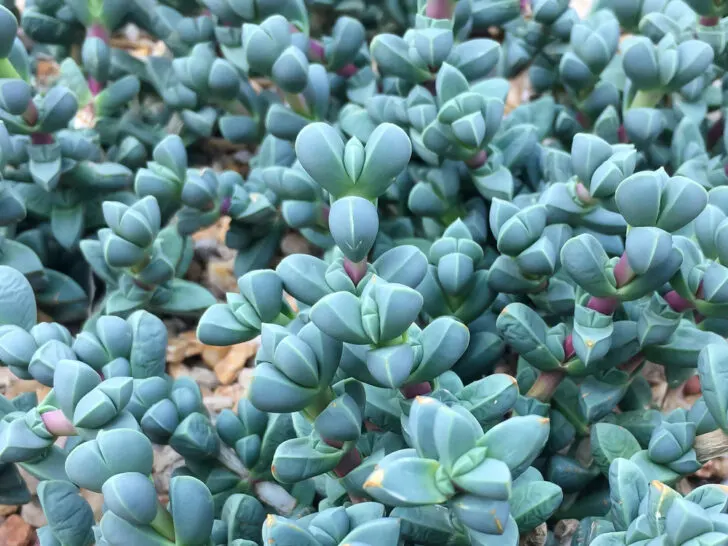
The Corpuscularia lehmannii, more commonly known as the ice plant, is a beautiful and unique succulent that is native to South Africa. It’s called the ice plant due to the glistening crystals covering its leaves that resemble ice.
The ice plant has beautiful diamond-shaped, fleshy leaves that are bluish-green and is a small plant growing only about 8 inches (20 cm) tall and 12 inches (30 cm) wide. Despite its small size, this popular succulent is an absolute powerhouse – it prefers full sun and is drought-tolerant.
In spring and summer, small yellow flowers will appear, which make a beautiful contrast to the blue-green leaves.
Growing an ice plant is simple because you only need to water every 1 to 2 weeks after the soil has dried out completely.
If you’re looking for a low-maintenance yet eye-catching succulent for your garden, the ice plant is a great choice.
4. Echeveria ‘Blue Bird’
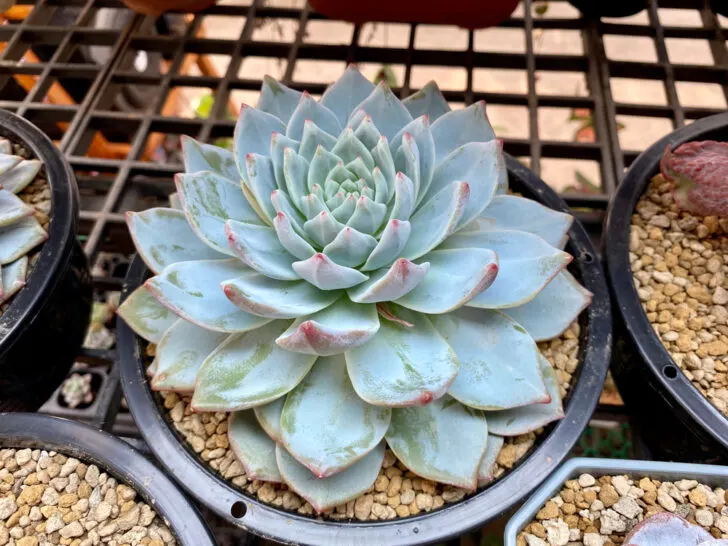
The blue bird succulent or Echeveria is a gorgeous blue succulent and gets its name from its lovely blue hue and bird-like shape.
This succulent thrives in sunny gardens and can reach a diameter of 12 inches (30 cm). Mature blue birds can have a lifespan of a few years to several decades.
Unlike many other plants, the blue bird doesn’t need much maintenance. The plant forms rosettes of thick, silvery-blue leaves with a powdery coating, making it the ideal plant for
anyone looking to add a touch of color to their home.
It thrives in bright sunlight and only needs to be watered about once a week. However, keeping an eye on the weather forecast during winter is essential.
Bring it indoors and place it on a sunny windowsill if you’re worried about your blue bird during chilly weather.
5. Echeveria ‘Blue Prince’

The blue prince, or Echeveria, is a perfect example of the beauty and diversity of succulents. This particular species can be distinguished by its blue-grey leaves and diminutive size.
A mature blue prince will reach a height of only 10 inches (25 cm) at maturity. However, what it lacks in size, it more than makes up for in color and texture.
Blue prince succulents have a luxurious, velvety texture due to the fine powder that covers their thick and bulky leaves. Although the leaves are blue-grey in color, they appear slightly red in direct sunlight.
If you decide to plant one of these delightful succulents in your garden, ensure that you place it in an area with plenty of direct sunlight because it needs a minimum of 6 hours of sunlight daily.
The blue prince is an effortless plant to care for but is prone to mealybugs. To prevent mealybugs from infesting your plant, check it regularly and remove any visible pests with cotton balls or swabs dipped in alcohol.
6. Pachyveria scheideckeri ‘Jeweled Crown’

Pachyveria scheideckeri, or jeweled crown, is another attractive blue succulent that has leaves in a rosette shape. This plant is an interesting hybrid between Pachyphytum and Echeveria.
Once your jeweled crown reaches maturity, it should have a height of around 2 to 6 inches
(5-15 cm) tall, and it should be as tall as it is wide.
The size and shape of the rosette and the leaves may vary from one plant to another. The fleshy leaves of the succulent are pale grey-green to red-flushed.
It’s easy to propagate your jeweled crown plant with leaf cuttings, allowing you to enjoy it for many years or to give it as a gift to someone.
Jeweled crown does well in a rock garden or as a potted houseplant in climates where it’s not cold. Under the intense sun or frosty conditions, the leaves usually turn a stronger red-pink.
This beautiful succulent is perfect for those who want something low-maintenance. If you’ve received your jeweled crown as a cutting, allow it to rest for up to a week to allow the callus to heal. After this, plant it in direct sunlight in a well-draining soil mix. You should only water a jeweled crown when the soil is dry to the touch.
7. Pilosocereus azureus ‘Blue Torch Cactus’
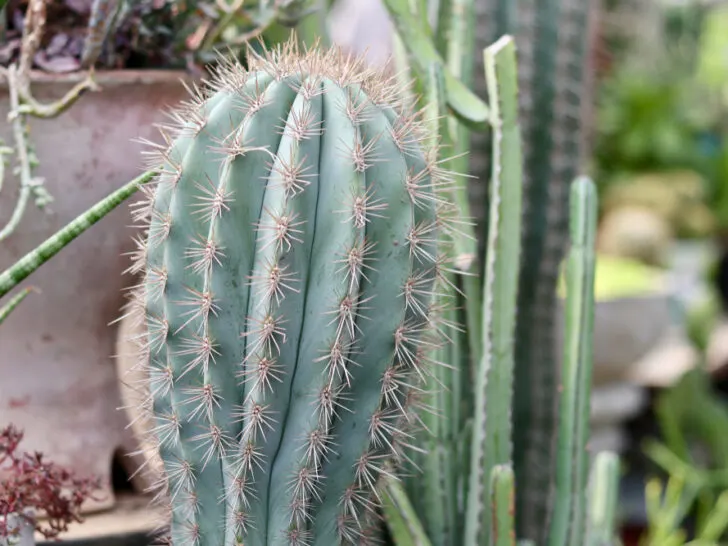
The blue torch cactus is an attractive South American plant that is so-called because of its pretty blue color in the stem when it matures.
When your blue torch cactus reaches maturity, you can expect it to grow 1 to 1.5 feet (30 cm to 46 cm) tall ennually. After this, it will continue to grow and can eventually reach an impressive height of 20 feet (6 meters). It’s, therefore, advisable to plant in a place where it has enough space to stretch out.
A blue torch cactus plant needs at least 10-12 hours of sun daily.
The white flowers on the blue torch cactus are pollinated at night by bats and sphinx moths, and they bloom when temperatures consistently exceed 70° F (21°C). The more sun they get, the more their stem will become bluer.
Blue torch cacti can also be rather fragrant, adding to their allure.
8. Senecio mandraliscae ‘Blue Chalksticks’
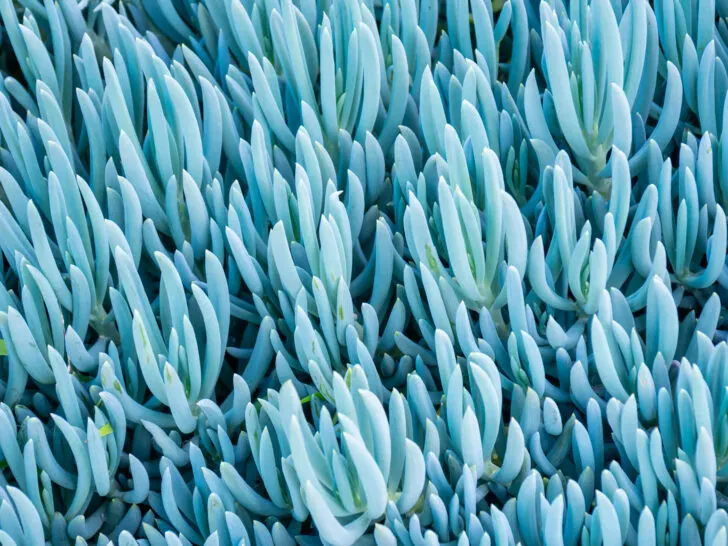
Are you looking for an eye-catching succulent to add to your garden? Senecio mandraliscae‘ or blue chalksticks is an attractive option that is sure to make a statement.
This South African native is fast-growing and forms dense, coral-like clumps. The dramatic blue-gray foliage is incredibly unique in shape and adds beautiful color and texture to any garden.
For those who are curious, blue chalksticks aren’t poisonous to humans but can be to pets. For this reason, don’t plant them if you have cats or dogs that like to nibble on plants.
As with other succulents, this one tolerates drought-like conditions well and prefers full sunlight to partial shade conditions.
It’s important to note that this succulent can get quite leggy if you don’t provide enough light. To keep your plant looking its best, pin the stems to encourage bushier growth.
Blue chalksticks is relatively low-maintenance and can tolerate neglect. Once established, it will need to be pruned annually to keep it looking its best.
If you’re looking for a showstopper of a plant, this succulent variety is a perfect choice.
Wrapping Up
Adding blue succulents can insert interesting color to your garden, and there’s a wide range from which to choose. Whether you prefer the elaborate butterfly agave or the small but beautiful blue prince, it will certainly make a fantastic addition.
Blue succulents are easy to maintain, making them great for beginners.

